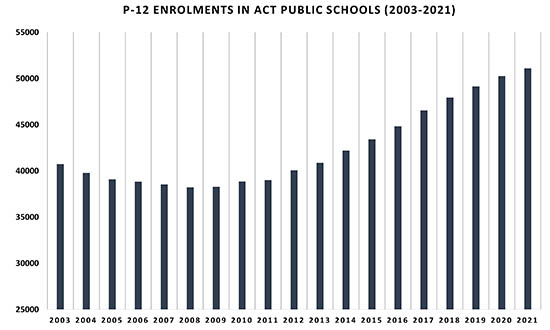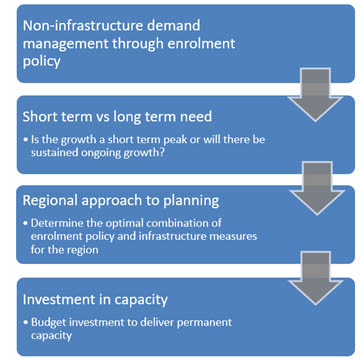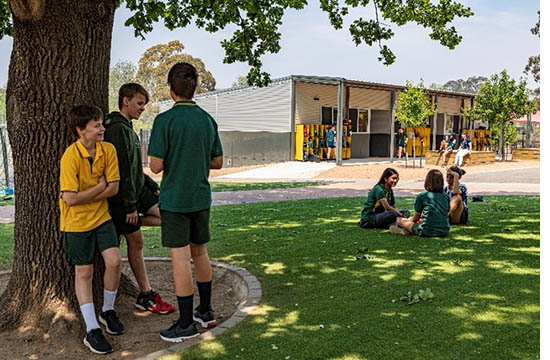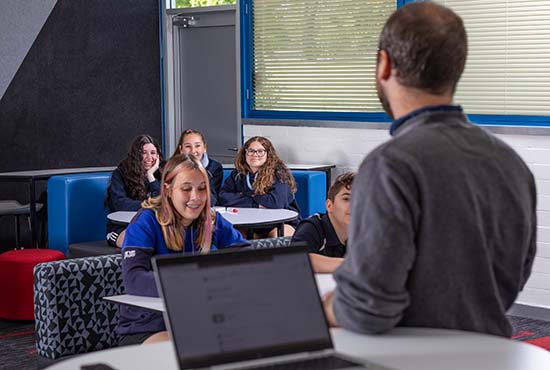The Education Directorate continues to upgrade and expand ACT public schools right across the Territory. We are working hard to ensure that every child has access to great, accessible and sustainable facilities and school infrastructure that support high quality education in our rapidly growing city.

Canberrans are showing a strong preference for public education, with growth in enrolments up by around 30% in the past decade. Enrolment growth is expected to continue for the next ten years, making capacity in our schools a key focus for the Education Directorate.
To accommodate all new students the Directorate investigates projected student enrolments paying particular attention to how Canberra’s regions continue to grow and change.
Some suburbs are experiencing an influx of young families with school age children while others have an aging population.
We work hard to predict those changes in order to respond with a planned, systematic approach to managing school capacity across the city.
Our options include building new schools, expanding and modernising existing schools or enrolment policy solutions to manage demand and deliver the right school capacity when and where it is needed.
We take a regional approach
Planning considers each school’s needs, growth, capacity and community, as well as the circumstances of the wider region.
A regional or district approach allows the Directorate to consider the most effective long-term capacity planning for the area and its schools.
Each region is unique and influenced by a range of factors such as new residential development and the changing makeup of households.
Working with other parts of the ACT Government, we analyse the long-term demographic lifecycle of suburbs across Canberra. This allows us to better understand how our city is changing in rapidly growing areas like Gungahlin and Molonglo, as well as our older, more established areas.
We then consider the impacts of this demographic lifecycle on current and anticipated demand for school places in the region, and for individual schools.
Enrolment forecasting
The Education Directorate considers a range of data sources to predict future student numbers.
We work closely with the Australian National University’s (ANU) School of Demography to produce detailed modelling of student numbers which has a high level of integrity.
Forecasts are dependent on the available information and are subject to change. Many factors will inform enrolment choices, such as changing enrolment policy, investment in school facilities, and broader population trends.
An important part of planning is predicting the number of children born in each area, anticipating where they will enrol in primary school and then projecting their journey as they progress onto high school and college.
We also consider trends reflecting family and student choices for public or non-government schooling.
Forecasting is regularly updated based on the results of the Education Directorate’s annual Census of ACT Schools which provides information on students enrolled at ACT schools each February.
Community engagement is an important element of the planning process. We consult regularly with our stakeholders including:
- ACT Council of Parents and Citizens Associations
- School P&Cs, Boards and school communities
- Industrial organisations including the Australian Education Union and Community and Public Sector Union
- Association of Independent Schools
- Catholic Education Office, Archdiocese of Canberra and Goulburn.

Options to increase capacity – policy change, expansion or new school?
The Directorate regularly reviews enrolment policy to respond to enrolment and population growth. Changes to Priority Enrolment Areas and out-of-area enrolments are two ways of managing growing demand for school places.
We divide our schools into two categories (A & B) so that families can more easily see if the school of their choice is able to accept enrolments from out of the school’s area.
- Category A Schools are generally not able to accept students from out of their area primarily due to current and projected capacity constraints
- Category B schools have some capacity to accept out of area enrolments
We also have NSW Pathway Schools which have the capacity to offer places to NSW based students.
If we predict a region will experience sustained enrolment growth, expansion of existing schools or building a new school may be necessary.
At older and established campuses new facilities or buildings provide an opportunity to increase capacity and modernise aging infrastructure.

Modular Learning Centres (also known as transportables) can be delivered reasonably quickly, providing the Directorate with the time to consider more permanent options to increase capacity. Many schools also choose to retain transportables as additional valuable learning spaces. More information on transportables can be found in the ‘Transportable Classrooms’ drop down below.
Where enrolment growth is expected to continue for a significant period, permanent expansions to existing schools are considered.
New schools are considered where sustained growth is expected to be ongoing, like in a new suburb.
New schools can be a challenge in established areas of Canberra where there is limited available land. We may respond to growth in these areas by expanding existing schools and using enrolment policy solutions.
Planning considerations include the need to provide adequate space for children to learn and play; safe and efficient road, cycle and pedestrian access; availability of school amenities and facilities such as playing fields and school halls/gymnasiums for the broader community; out of school hours care services; and the ability for the school to grow and adapt as student numbers and ages change.
Consultation with the community and working closely with other parts of ACT government ensures timely delivery of new and expanded schools.
The ACT Government is investing in new and expanded school infrastructure across Canberra. We are working hard to ensure our schools continue to have the right capacity to give all Canberra’s children and young people the opportunity for a great education.
New and Expanding Schools
The ACT Government invests record amounts in ACT public schools to meet current and future education needs and ensure every child in Canberra can access a great public school close to home.
As the city grows, more public schools are being built, and educational facilities are being improved in Canberra. This means people moving to new suburbs and growing regions can access public education near their homes.
Comprehensive planning and work ensure schools are easy to get to, well-designed, inclusive, sustainable, safe, and can accommodate all the students in the area.
Major school infrastructure projects recently completed and currently underway include:
- Margaret Hendry School’s expansion accommodates up to 600 places, with new learning communities ready this year. Find out more on the Margaret Hendry School website: https://www.margarethendryschool.act.edu.au/infrastructure_update

- The ACT Government has invested $85 million in a Shirley Smith high school in the suburb of Kenny for 800 students. Enrolments are now open ahead of the new school opening in 2024. Find out more on the high school in East Gungahlin website: https://www.education.act.gov.au/East-_Gungahlin_High_School/about-our-school

- Construction has commenced on the new high school in Taylor, which will open in 2025. The school will cater for up to 800 year 7 to 10 students and provide high-quality general and specialist learning environments. Find out more on the high school in North Gungahlin website: https://www.education.act.gov.au/North_Gungahlin_High_School/home

- The ACT Government has invested $43.9 million in a new primary school in Throsby for 450 students and 130 preschool students, which opened in 2022. Find out more on the Throsby School website: https://www.throsbyschool.act.edu.au/

- The ACT Government invested $29 million to expand Franklin School, which created an additional 400 places ready for 2022.
- The ACT Government invested $12.73 million to expand Amaroo Senior School, creating an additional 200 places, completed in 2022.
- The expansion of Gold Creek Senior School created an additional 200 places and was completed in 2022.
- The ACT Government invested $70 million in the first high school in Molonglo Valley. Evelyn Scott School in Denman Prospect Senior School campus accommodates and opened for the 2023 school year.
- The modernisation of Campbell Primary School delivered state-of-the-art learning facilities with landscaping works to be completed in 2023.
- Design work for the modernisation of Garran Primary School has commenced. The modernisation will deliver all new learning areas and increase the school’s capacity. Find out more on the Garran Primary School website: www.garranps.act.edu.au/school_modernisation

- Design work for the modernisation of Majura Primary School has commenced. It will deliver some new learning areas, new gym and refurbishment of existing school in line with budget and will increase the school’s capacity to by 300 student places. Find out more on the Majura Primary School website: www.majuraps.act.edu.au

- Initial design works are underway for the modernisation of Narrabundah College.
- Design work is underway for Ginninderry’s first preschool to year 6 school and early childhood education centre in Strathnairn.
- Design work is underway for Whitlam’s first preschool to year 6 school and early childhood education centre.
School Infrastructure upgrades and improvements
ACT public schools have improvements every year, with many of these upgrades required to ensure inclusive facilities so that all students can take full advantage of educational opportunities.
These infrastructure investments will help cater to the ACT’s growing population and continue to ensure that there is a place for every child in their great local public school.
The Public School Infrastructure Renewal Program (PSIRP) is an annual rolling program funding upgrades to school facilities and infrastructure at ACT Public Schools. Each year schools can apply for funding through the PSIRP budget.
The latest round opened in October 2022 for the 2023-24 PSIRP budget allocation, and more than 60 schools submitted applications for over 320 individual infrastructure projects. The opportunity to apply for the next PSIRP budget allocation will open in September 2023.
All proposals received were assessed using the Education Directorate’s Project Prioritisation Tool.
This year 51 school projects in 37 schools will receive funding for infrastructure projects through the PSIRP budget.
Schools receiving upgrades through the 2023/24 PSIRP budget:
- Evatt Primary School: Upgrades to specialist science and art classrooms, toilets and landscaping.
- Florey Primary School and preschool: Upgrades to staff facilities
- Mt Rogers Primary School: Upgrades to staff facilities.
- Giralang Primary School: A new LED school sign installed.
- Latham Primary School: New external outdoor learning space and accessible ramps.
- Macquarie Primary School: Classroom and staff facility upgrades.
- Melba Copland Secondary School: Classroom upgrades.
- UC Lake Ginninderra College: IT room and toilets upgraded.
- Belconnen High School: Gym changing room upgrades.
- Ainslie Primary School: An Early Years learning setting will be repurposed from the Out of School Hours Care site, front office, and sick bay upgrades.
- Campbell High School: New bike shelter.
- Lyneham Primary School: Classroom upgrades.
- Lyneham High School: Upgrade bike shelter.
- Harrison School: Upgrades to their staff facilities.
- Ngunnawal Primary School and Preschool Upgrades to their external learning areas.
- O’Connor Cooperative School: Car park resurfacing.
- Palmerston District Primary School: Landscaping.
- Forrest Primary School: First aid room upgrades.
- Arawang Primary School: New school hall air conditioning and outdoor learning area
- Curtin Primary School: New accessible stage and shade structure
- Duffy Primary School: Upgrades to preschool amenities
- Farrer Primary School: Upgrades to staff amenities and a new shade structure
- Hughes Primary School: A new covered outdoor learning environment
- Lyons Early Childhood School: Upgrades to the front of the school
- Malkara School: Gym will be upgraded.
- Woden School: Upgrades to the school hall and a new shade structure.
- Melrose High School: LED lighting throughout school.
- Telopea Park School: Sick bay upgrades.
- Birrigai: Updated signage, upgraded footpaths, access ramps and wheelchair access, a new safe all-weather teaching and learning space and student rest area.
- Erindale Leisure Centre: Student bathroom upgrades
- Gilmore Primary School: A new bike enclosure, teaching kitchen canteen upgrades, staff facility upgrades.
- Gordon Primary School: A new fence around the oval and a new external learning area
- Isabella Plains Early Childhood School: Staff facility upgrades
- Monash Primary School and Preschool: Oval upgrades, front office upgrades and staffroom carpet upgrade.
- Namadgi School: Installation of covered walkways
- Richardson Primary School: Canteen and student toilet upgrades
- Theodore Primary School: New LED signage
Other school infrastructure upgrades include the school’s receiving energy efficiency improvements, such as installing solar panels, safety improvements such as new car parking facilities, and modifying school facilities with inclusive upgrades to support students with complex needs and disabilities.
We are focused on providing healthy and comfortable teaching and learning spaces to maximise the learning outcomes for all children. Ecological Sustainable Development (ESD) plays a key role in achieving this goal through project design and the efficient management of natural resources. The Directorate’s strategic priorities for ESD align with the ACT Government’s commitments to; energy efficiency and greenhouse gas (GHG) reductions, waste minimisation and resource recovery, water efficiency, living infrastructure, sustainable procurement and sustainable transport.
Climate-change-and Future Schools
Sustainable design is integrated into new schools, major projects and capital upgrades to support the ACT government’s 2045 net zero greenhouse emission target. The target established under the ACT Climate Change and Greenhouse Reduction Act 2010, has driven significant progress including the uptake of renewable energy and the integration of sustainable design principles across the ACT public school portfolio.
The provision and upgrade of sustainable school infrastructure is viewed as key to supporting teaching and learning activities and is a visual statement of the ACT Government’s commitment to a sustainable future for current and future generations.
In 2019 the new Margaret Hendry School was the first ACT Public School designed to operate using 100% electricity. This enabled the school to take advantage the ACT’s transition to 100% renewable electricity by 2020 and produce zero emissions in its operations. The school integrates sustainable design features including onsite generation of electricity via a 100kW solar array, solar passive design, natural ventilation, double glazing and energy efficient heating and cooling systems.
Energy Efficiency and Building Comfort
To assist schools to be more efficient in their energy use and improve the comfort of students and staff, a program of targeted upgrades and building audits is undertaken annually. The program includes building envelope improvements to enable better maintenance of internal temperatures by preventing heat loss in winter and heat gain in summer, improved efficiency of building heating and cooling systems to assist in reducing gas and electricity usage, and capacity building through the provision of skill development workshops and information sessions for Building Service Officers and Business Managers.
Recent projects include double glazing upgrades to select areas at North Ainslie Primary School (building on an open plan classroom and corridor upgraded 2016-17), Southern Cross Early Childhood School and Wanniassa Hills Primary School. Energy monitoring is taking place to determine the effect of the works on energy consumption. Significant improvement in student and staff comfort has been recorded.
External Learning Environments (ELE)
Engaging, sustainable playgrounds are a key focus in delivering a rich outdoor learning environment, supporting positive social experiences for school children and reinforcing connections with the natural environment. A series of programs under this banner ELE deliver landscape master plans to support schools as they progressively develop their grounds, a tree planting program to provide cool seasonal shade to outdoor play spaces and buildings as well as select and construct landscape projects as exemplars that support student needs, are cost effective, reflect current best practice for environmental sustainability and provide a balance between artificial and natural play spaces.
A Tree Planting Program initiated in 2017-18 involved the planting of advanced tree specimens to provide shade to buildings, reduce the impact of heat banking surfaces, provide cool shade to students and playgrounds, and replace trees at end of life. In 2018-19 a further 98 trees were planted across nine schools including Bonython Primary, Caroline Chisholm (senior and junior campuses) Fadden, Hawker Primary, Monash Primary Wanniassa Hills and Yarralumla Primary Schools.
As our city continues to grow, it is vital that our high-quality education system grows with it. The number of Canberra public school students increases by about 3% each year, and as outlined above the ACT Government continues to plan strategically for this growth. Student numbers rise and fall over the life cycle of a suburb and schools are built with the ability to be scaled up and down to respond to these changes.
The ACT uses purpose-built transportable buildings which are fitted out as classrooms. These transportable classrooms provide flexibility for schools, while being open, spacious and modern. They can be customised to meet the needs of schools and include a range of specialised learning spaces such as science labs, art studios and home economic rooms.
Transportable classrooms are planned for and placed in areas that blend into the overall design and landscaping of a school and come with all the same comforts and technology as a permanent learning space. Transportable classrooms allow schools to be flexible and provide modern, high-quality education.
This investment in schools forms a key part of this Government’s ongoing work in delivering the services Canberrans need not only today or tomorrow but in years to come. Watch our video to learn more about transportable learning spaces in ACT Public Schools.
Red Hill Primary
The ACT Government ACT Infrastructure Plan, is a multi-decade plan detailing over $14 billion worth of infrastructure investments across Canberra. It focusses on priorities such as health, education - including new schools in our suburbs, transport and community services which will help Canberra cater for a city of 500,000 people by 2030. For more information, click ACT Infrastructure Plan ![]() .
.

